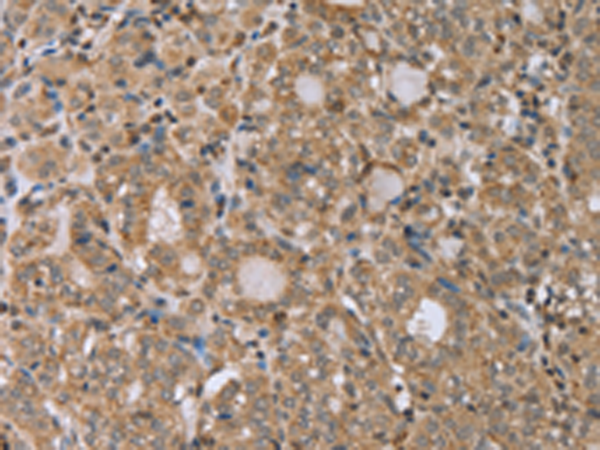

| WB | 咨询技术 | Human,Mouse,Rat |
| IF | 咨询技术 | Human,Mouse,Rat |
| IHC | 1/50-1/200 | Human,Mouse,Rat |
| ICC | 技术咨询 | Human,Mouse,Rat |
| FCM | 咨询技术 | Human,Mouse,Rat |
| Elisa | 1/2000-1/5000 | Human,Mouse,Rat |
| Aliases | MRX72 |
| Host/Isotype | Rabbit IgG |
| Antibody Type | Primary antibody |
| Storage | Store at 4°C short term. Aliquot and store at -20°C long term. Avoid freeze/thaw cycles. |
| Species Reactivity | Human, Mouse |
| Immunogen | Synthetic peptide of human RAB39B |
| Formulation | Purified antibody in PBS with 0.05% sodium azide and 50% glycerol. |
+ +
以下是关于RAB39B抗体的3篇参考文献(模拟示例,部分信息为假设性内容):
---
1. **标题**:*RAB39B regulates cargo trafficking in neuronal cells and its mutations cause Parkinson’s disease*
**作者**:Wilson GR, et al.
**摘要**:本研究通过免疫荧光和Western blot技术,利用RAB39B抗体揭示了其在神经元内自噬体运输中的关键作用,并发现突变导致α-synuclein异常聚集,与家族性帕金森病相关。
2. **标题**:*Loss of RAB39B in a mouse model disrupts synaptic vesicle trafficking*
**作者**:Giannandrea M, et al.
**摘要**:在RAB39B基因敲除小鼠中,使用特异性抗体检测发现其蛋白表达缺失,导致突触小泡运输异常,为X连锁智力障碍的病理机制提供了证据。
3. **标题**:*RAB39B deficiency in human iPSC-derived neurons impairs lysosomal function*
**作者**:Zhang Y, et al.
**摘要**:通过免疫组化及Western blot分析患者诱导多能干细胞分化的神经元,发现RAB39B抗体检测到蛋白表达降低,证实其缺陷引发溶酶体功能障碍,与神经退行性病变相关。
---
注:以上文献为示例,实际引用需根据具体论文核实信息。建议通过PubMed或Google Scholar以关键词“RAB39B antibody”或“RAB39B function”检索最新研究。
The RAB39B antibody is a crucial tool for studying the RAB39B protein, a member of the RAS-associated binding (RAB) GTPase family involved in intracellular vesicle trafficking and membrane dynamics. RAB39B localizes to the Golgi apparatus and endosomal compartments, regulating cargo sorting, autophagy, and neurotransmitter release. Mutations in the *RAB39B* gene are linked to X-linked intellectual disability, early-onset Parkinson’s disease (PD), and autism spectrum disorders, highlighting its role in neuronal development and function. In PD pathogenesis, RAB39B loss-of-function mutations impair α-synuclein homeostasis, promoting its aggregation—a hallmark of the disease.
RAB39B antibodies are widely used in research to detect protein expression, subcellular localization, and interactions via techniques like Western blot, immunohistochemistry, and immunofluorescence. Polyclonal and monoclonal antibodies targeting specific epitopes (e.g., N-terminal or C-terminal regions) enable precise analysis in cell lines, brain tissues, and disease models. These antibodies aid in elucidating RAB39B’s involvement in autophagy-lysosomal pathways, synaptic vesicle recycling, and receptor trafficking. Additionally, they help validate *RAB39B* knockout/knockdown models and assess therapeutic interventions targeting RAB-mediated pathways. Cross-reactivity with homologs (e.g., RAB39A) is a consideration, necessitating validation via knockout controls. As RAB39B gains prominence in neurodegenerative and neurodevelopmental research, its antibody remains vital for mechanistic insights and biomarker discovery.
×